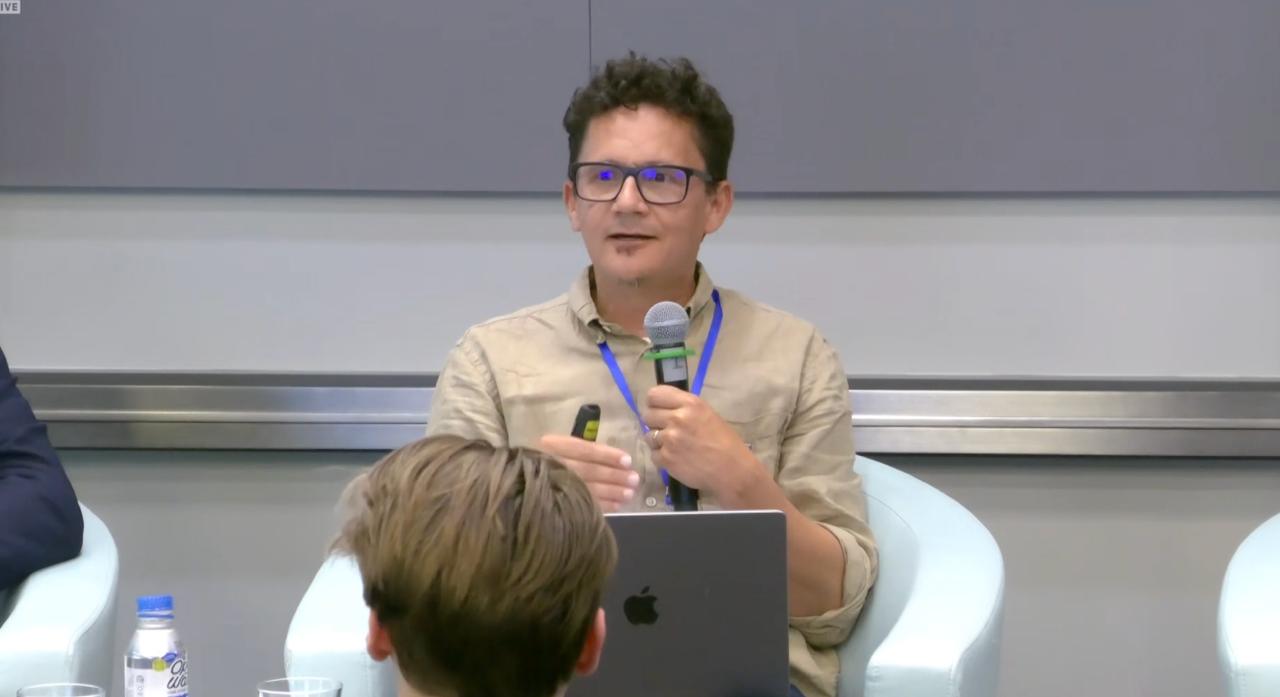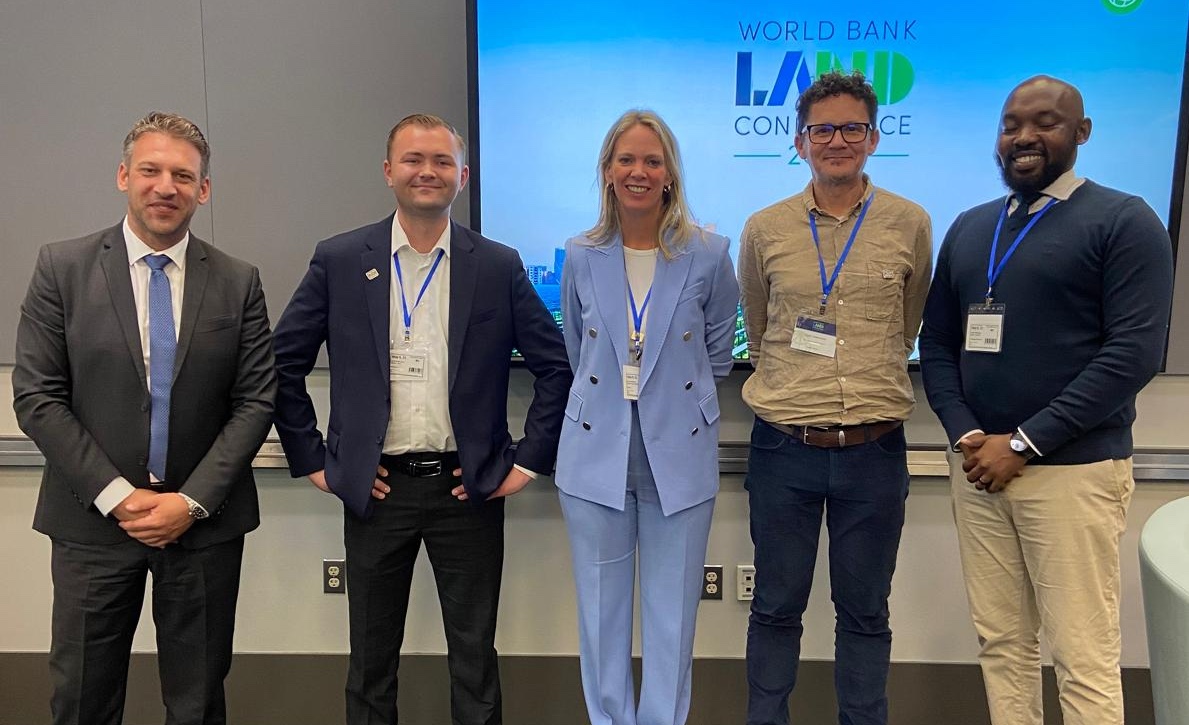As the world races toward climate resilience and sustainable development, one truth grows clearer: we cannot reach a just energy transition without just land governance. On May 6, 2025, the World Bank Land Conference hosted the session “From Data to Action: Tools to Monitor Corruption, Improve Transparency, and Enable a Just Energy Transition” to tackle the persistent challenge of land corruption and transparency head-on. Drawing from case studies across Africa, Latin America, and the Western Balkans, panelists made a compelling case for transparency as both a shield against corruption and a catalyst for climate justice.
The session explored how tools like the Corruption Perceptions Index (CPI) and the State of Land Information Index (SOLIndex) can diagnose governance blind spots, benchmark national progress, and guide action. Moderated by Caleb Johnson of the World Bank, the session brought together Jonathan Ochom (Transparency International), Charl-Thom Bayer (Land Portal Foundation), Christelle van den Berg (Kadaster International), and Darko Vucetic (Republic Geodetic Authority of Serbia).
A Crisis of Trust, Transparency, and Tenure
Caleb Johnson opened the session with a stark warning: “One in five people globally has been affected by corruption in land management.” This corruption not only threatens equitable access to land, but also erodes public trust and undermines climate investments such as renewable energy infrastructure. Johnson emphasized that land is more than a commodity—it is a foundation for community, resilience, and justice.
“Transparency, accountability, and data-driven governance are not optional—they are essential for ensuring land governance supports rather than hinders a just energy transition.” — Caleb Johnson, World Bank
Diagnosing the Problem: What the Data Shows
Jonathan Ochom of Transparency International launched the session’s first presentation with findings from the CPI. His analysis revealed a dire reality: nearly 70% of countries fall into the high-risk quadrant of high corruption and low transparency.
“The land sector is among the least transparent globally. Land data scores just 25 out of 100—far behind sectors like procurement or public finance,” said Ochom. “If your child brought home a score of 25, would you be proud?”
Ochom explained that weak transparency in land administration fosters conditions for grand corruption, including land grabs and the illicit enrichment of elites under the guise of economic development.
“We found that even countries making progress on corruption control, like Rwanda or Costa Rica, still lack open land information systems. Without transparency, legal reforms and anti-corruption efforts are toothless,” he noted.

Enter the SOLIndex: Diagnosing Gaps, Guiding Reform
Next, Charl-Thom Bayer, Senior Land Information Specialist at the Land Portal Foundation, introduced the SOLIndex. Based on data from 42 countries, the index measures two components: completeness (whether governments collect essential land data) and openness (how accessible and usable that data is).
“This isn't just about open data for its own sake,” said Bayer. “We assess data on land tenure, land use, land value, and legal frameworks—because these are where rights are documented, taxes are assessed, and power is negotiated.”
The average SOLIndex score? A sobering 14.6 out of 100. Completeness averaged 31/100; openness, 46/100. The weakest category was land valuation data related to land value assessments of land and properties, revenues through taxation, and land markets.—scoring just 6/100.
“Valuation data is critical to understanding how land is used, taxed, and transferred. Its absence opens the door to speculative investments and opaque acquisitions that displace vulnerable communities,” Bayer explained.
Why Data Gaps Matter: Land Corruption Undermines Climate Action
The panel then moved to discuss corruption as a barrier to climate resilience and energy transition.
Ochom emphasized that large-scale land acquisitions for green projects, such as carbon offsetting or renewable energy, often replicate patterns of exploitation.
“Projects promoted under climate goals are being used to dispossess Indigenous Peoples and pastoralist communities, particularly in East Africa,” Ochom warned. “We call this green grabbing. It’s the same colonial playbook—just painted green.”
Bayer added that trust is essential to making land data useful and actionable.
“Data must be free of political interference, representative of society, relevant to public needs, accessible to all, and used effectively. These are the building blocks of trust,” he said. “Without trust, no amount of data will matter.”
Practical Challenges—and Real Solutions
Darko Vucetic, Assistant Director for Development and Innovation at Serbia’s Republic Geodetic Authority, offered a vivid example of how digital transformation can combat corruption. He explained that the country’s transition from paper-based chaos to a fully digital land administration system was not just technical—it was political warfare.
“Transparency is a struggle,” Vucetic declared. “It means breaking the monopoly of informal groups that profit from opaque systems. We faced massive resistance—but full digitalization and full transparency were our only path forward.”
One transformative reform Serbia implemented was the mandatory registration of both spouses during property transfers—raising women’s ownership to over 40%, the highest in the region.
“We achieved the SDG gender indicator and rebuilt public trust. But it required courage, legal reform, and support from international allies like the World Bank, FAO, and Land Portal,” he said.
A View from the Global Cooperation Lens
Christelle van den Berg, Regional Manager at Kadaster International, highlighted the institutional barriers to transparency. While technical problems are solvable, she argued, institutional inertia and personal interests are harder to overcome.
“The biggest challenge is that benefits from transparency usually appear long after political terms end,” said van den Berg. “Why would a politician support reform if the returns come 10 years later—and in the meantime, there’s money to be made from opacity?”
She called for strong leadership and international cooperation, noting that open data initiatives often depend on donor coordination, legal frameworks, and training. Kadaster’s Dutch Geoportal example—used to plan transformer stations in the Netherlands—demonstrates how layered, interoperable data can lead to better decisions and reduce land use conflicts.
From Policy to Practice: Tools and Takeaways
Ochom and Bayer concluded with practical tools and recommendations:
- Disclose land deal documents and contracts. This includes risk assessments, licenses, and agreements with affected communities.
- Digitize and open land records. Data should include customary and communal rights, land use, and beneficial ownership.
- Involve civil society and communities. Integrity pacts, citizen monitoring, and grievance redress mechanisms are essential for public oversight.
Ochom cited the Uganda National Land Information System, Kenya’s Ardhi Sasa, and TI-Zambia’s Land Transparency Portal as examples where governments and CSOs are using tech to fight land corruption.
“Anti-corruption policies must move off paper and into practice,” said Ochom. “That means enforcement, civil society engagement, and digital tools that make corruption harder to hide.”
Bayer added that the SOLIndex is more than a performance score—it’s a roadmap for governments, donors, and communities.
“By benchmarking gaps and tracking progress, the SOLIndex helps turn data into dialogue—and dialogue into reform,” he said.
Conclusion: Turning Transparency into Transformation
As the session drew to a close, the message was clear: data transparency is not just a technical goal—it is a political and ethical imperative. From Serbia’s hard-fought reforms to community-led oversight in Africa, the session demonstrated how transparency can dismantle corruption, empower communities, and unlock climate justice.
The path forward is challenging. It requires legal reform, digital infrastructure, inter-agency coordination, and a cultural shift toward openness. But it also offers powerful returns: restored trust, equitable access to land, and climate action that leaves no one behind.
“Ultimately, transparency is about justice,” concluded Johnson. “And if we want a just transition, we must start by opening the books.”

